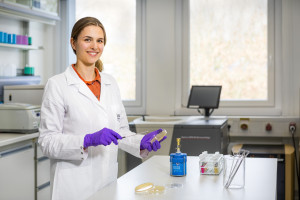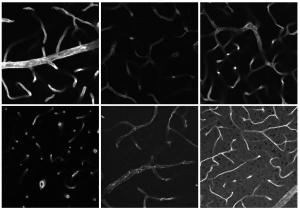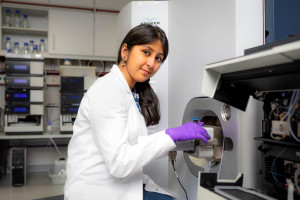Dortmund, 1st April 2022

Bacteria such as Escherichia coli (E. coli) play an important role in Kaja Reiffert’s research. The young scientist monitors the development of the bacterial strains she has cultivated and treated.
Kaja Reiffert (24) is a doctoral student in the Bioimaging working group. In her dissertation, she studies the effects of ultra-small silver nanoparticles on the human body. In order to learn more about her work in the lab, the editorial team asked Kaja to finish the following sentences.
-
At ISAS I am working on…
investigating the influence of ultra-small metallic nanoparticles (1-2 nm small) on eukaryotic and prokaryotic cells. Eurkaryotes are, for example, fungi, animals or plants. Bacteria are prokaryotes.
-
This research question is important because…
nanoparticles could potentially prevent bacterial infection in connection with implants in the clinic.
-
My theory is…
that ultra-small silver nanoparticles show an enhanced antimicrobial effect, but also cytotoxic activity. This means there is a chance that they kill bacteria, but damage our cells at the same time. I want to find out whether I can modulate this ‘toxic’ activity through a combination of different metals and thus adjust it to eukaryotic and prokaryotic cells.
-
The equipment I use most in the lab is…
the confocal microscope for my analysis of fluorescence-marked nanoparticles.
-
My experiments are…
amongst others, so-called vitality assays, the cultivation of eukaryotic and prokaryotic cells as well as analyses with microscopes and a flow cytometer. I am always planning new experiments.
-
My highlight every day is…
to be able to look back on a productive and eventful day.
Kaja Reiffert is doing her PhD at the University of Duisburg-Essen. The title of her dissertation is "Ultra-small Mono- and Bi-metallic Nanoparticles as a Possible Prevention Strategy of Implant-associated Infections" (Ultrakleine mono- und bimetallische Nanopartikel als mögliche Präventionsstrategie Implantat-assoziierter Infektionen). Her work contributes to the research project "Synthesis, structure, and biological effects of ultrasmall (1-2 nm) bimetallic silver-platinum nanoparticles". The German Research Association (DFG) funds the project under the number 452179459.








